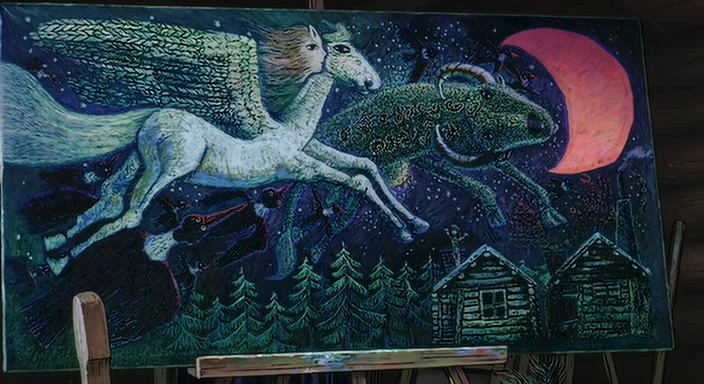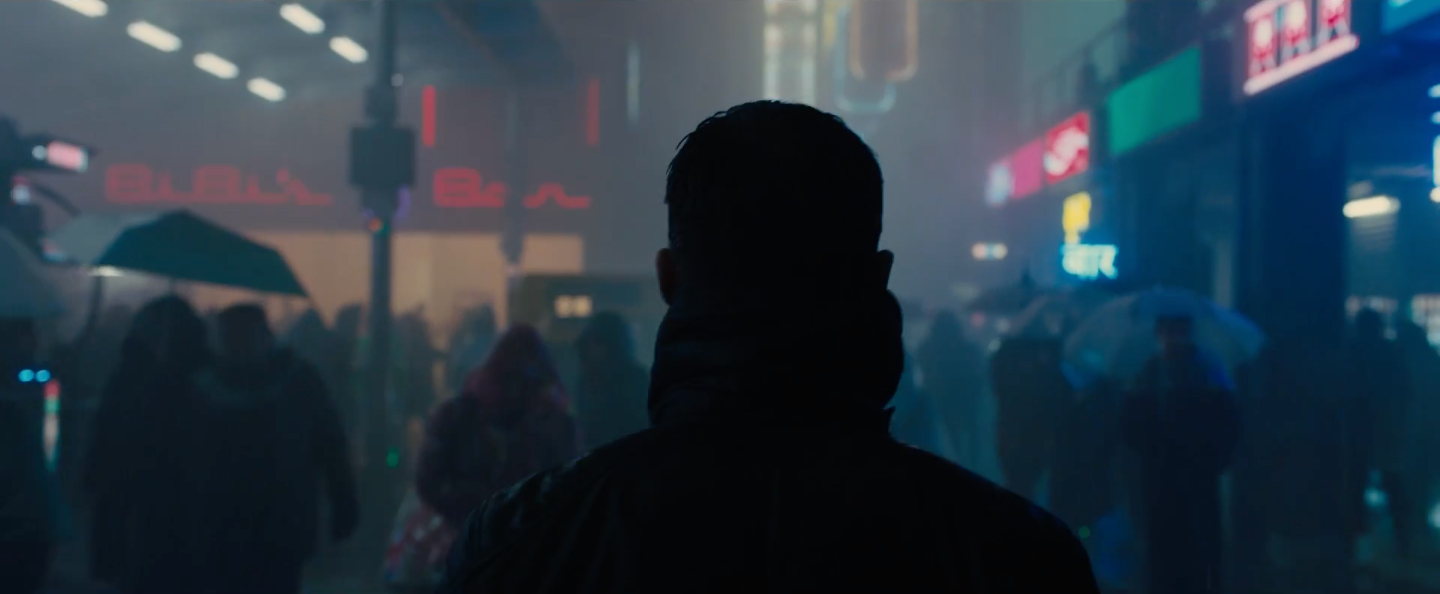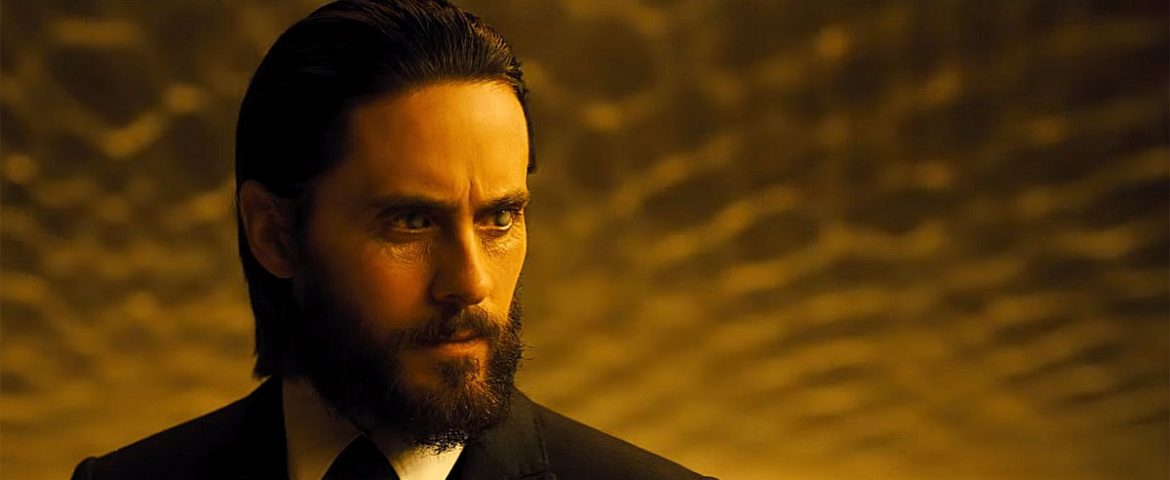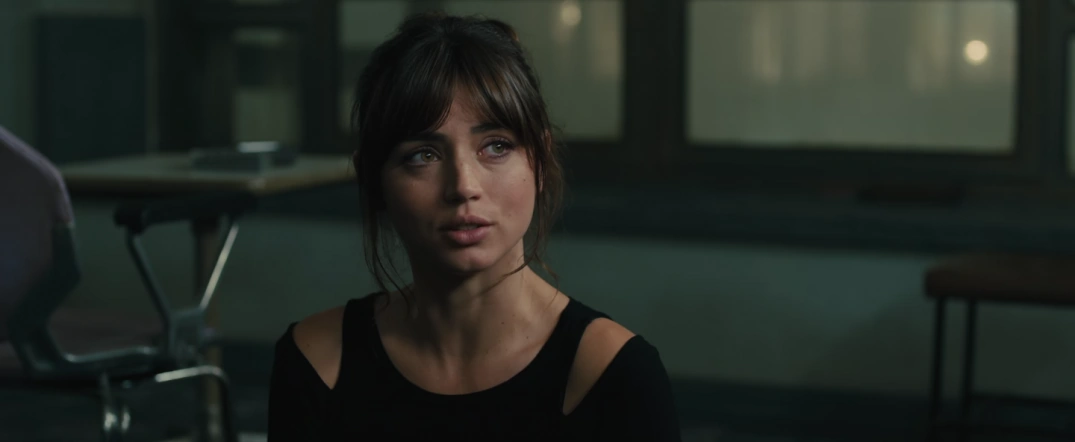My Neighbour Totoro was always going to be a tough act to follow. However, Miyazaki found a clever way to almost pick up where Totoro leaves off. What happens to children when they begin to grow up? In Kiki's Delivery Service, Miyazaki explores the story of the titular character, on the verge of becoming a teenager, learning what it is like to live in the real world. Based on the popular Japanese children's books by Eiko Kadono, the film bares a passing resemblance to the novels (to the point where the author almost boycotted the project) however Miyazaki imbued Kiki with a mature and subtle tale of growing up fast.
I must admit though - it's taken me a very long time to come around to Kiki's Delivery Service. Kiki used to be on the lower end of my favourite Miyazaki's films but it has slowly crept up in my estimations and is comfortably on the higher end. When I first started getting into Ghibli in my early teens, Kiki always fell by the wayside a bit for me. Nestled between the madness of Spirited Away and Howl's Moving Castle, the whimsy of Totoro and the epic, action-adventures of Nausicaa, Laputa and Mononoke, the film never really struck a chord with me the way the other Miyazaki films did. I could certainly see its merits, sure, but I mostly wrote it off as light and a bit fluffy. I used to think it was trying to match that light plotted style of Totoro but didn't quite hit the mark. I mean there's a five minute sequence dedicated to baking a pie.
 |
| Kiki sets out on her exciting, and slightly imposing, adventure |
In 2010, I moved to Hull for university. This meant I would be living independently for the first time in my life. It was a time that basically made me who I am today, experiencing both the highs and lows life can offer and getting a real dose of reality. When I returned home from uni, I somehow ended up re-watching
Kiki and then the film's power hit me like a ton of bricks. The whole thing made so much more sense to me having gone through the uni experience - leaving home, finding my feet and working out just who I was and where I fitted in (a process that is still continuing to this day). It wasn't easy (there were some awful times but also plenty of great ones) but I came out a stronger person on the other end, which helped kick start my adult life. After living my own life for three years, all of sudden Kiki's high and lows of living independently and settling into a new place became incredibly relatable. Kiki only being able to afford one type of meal? Check. Kiki awkwardly meeting new people? Check. Building a surrogate family of friends? Check. Having a day where the world seems completely against you? Check. I now view Kiki as one of Miyazaki's best and most subtle films.
Kiki's Delivery Service follows the titular character who has just turned 13 and also happens to be a budding witch. As is tradition to better their craft, witches spend a year away from their home to better their skills. Kiki, along with her cat familiar Jiji, embarks on her year-long journey with no real plans or any idea how she is going to support herself. She ends up in the port town of Koriko and soon befriends Osono, a bakery owner and heavily pregnant. In exchange for accommodation and help around the shop, Kiki helps Osono uses it as the base of her budding flying delivery service (as flying her broomstick is one thing she is kind of proficient in). The film follows Kiki as she tries to navigate independent living, whilst brushing off advances by the local geek Tombo and learning what it means to grow up ...
 |
| Kiki ponders when is the perfect time to leave home |
The opening ten minutes or so are simply perfect, deftly setting up the main character and themes the film are going to explore. There's a long sequence in which Kiki decides that she is going to leave that night (due to the full moon being out), announcing this to her parents and making her slightly haphazard exit into the wild world, with no real plan on where she is going to go and how she is going to support herself. The film frames this as exciting to Kiki, it doesn't come down on her choosing to do this potentially dangerous mission! Her mum even says that it's not really a thing that witches do anymore, but Kiki is determined nonetheless. Her snide talking cat Jiji is also introduced, acting as something of the voice of the reason to Kiki. I love the scene where Kiki and her dad talk about her leaving. In a tender moment, he attempts to pick her up and spin her around, like he used to do when she was younger, but struggles! He just can't believe how quickly his daughter has grown up. With all her friends and family gathered on the perfect night, Kiki sets off on her broomstick. As a side-note, I love the way flying is animated in this film. It's not as graceful as Harry Potter and there's a real sense of weight to it, which is something fairly unique to Kiki. After the upbeat J-Pop of the opening credits subside, Kiki encounters another witch flying over a local town. She's a little bit uptight but gets Kiki thinking - how is she going to support all this? This young witch is clearly comfortable in herself and is making a living as a fortune teller. Kiki doesn't have any skills outside of flying...what is she to do?
After some flying and a stay on an overnight train moving cattle, Kiki and Jiji end up by the coast and look upon the port town of Koriko. The establishing shots of Koriko are simply breath-taking. I discussed previously the concept of Paris no Akage, or Paris of our Dreams, but I would describe this setting as Germany of our Dreams. With its gorgeous gothic architecture (with an imposing clock tower looming over the town), the slightly worn but lovingly aged buildings, clearly Germanic font and the bright colours all contribute to creating a sense of an alternative, slightly exaggerated, take on Europe. Kiki's arrival into the town is nothing short of magical, as we become acquainted with the environment we are going to spend the rest of the film in. However, this is snapped when Kiki causes a major traffic incident as she flies along the streets and gets into trouble with the police over it but manages to sneak away. I love the scene where she is in the park having her lunch and a police car pulls on the other side. With childlike paranoia, she packs up and leaves. The weight of everything begins to pile on Kiki - what has she done? Where is she going to live? How is she going to survive? When all hope seems lost, she bumps in Osono, who is calling after a woman who has left her bakery without picking up her baby's dummy (or pacifier)! Kiki grabs it and flies down to the woman. Following this success, Osono suggests she open a delivery business with a fairly unique selling point and even offers her the spare room around the back of the bakery! The only condition is that Kiki help out at the bakery as she is heavily bakery. As if by pure luck, Kiki seems set up and looks relatively set.
 |
| The visuals of the film are to be marveled at, showing off Miyazaki's interests in fusing different culture's art styles together |
 |
| Kiki's not so graceful entrance into town |
The film then settles into an episodic groove, as Kiki takes on different jobs and gets acquainted with her new life. I love the scenes of her going food shopping for the first time and realising just how much everything costs. Pretty soon, she finds her money dwindling and has to resort to cooking very cheap meals for her and Jiji (mostly pancakes). I can relate to this situation all too much. She looks on in shop windows at clothes and shoes she can't buy, as other, more affluent girls walk by with seemingly everything. Again, something I can relate to as an ex-student. Minus the girl and possibly shoe parts. Anyway, she doesn't have time for trivial things like this, as she has a delivery business to run (though having them pretty red shoes sure would be nice). She first must deliver a stuffed toy to a little boy as his birthday present from his absent minded aunt. Things get complicated along the way when she drops the present into the middle of a forest and has to fend off some crows to retrieve it back. However, it is here that she makes a new friend, an artist named Ursula who is stopping in the middle of the woods for artistic inspiration. This sequence is perfectly judged for tension and comedy, in particular when Jiji has to pretend to be the stuffed toy, while Kiki retrieves the real present (coincidentally, the stuffed toy looks like Jiji) and befriends the little boy's elderly dog.
Kiki then has to deal with a lull in popularity, as she seemingly does not get many delivery requests. Then, all of a sudden she is busy again! She has a request from an elderly (eccentric) woman to deliver a freshly baked pie to her grand-daughter's birthday party. However, her modern electric oven is not working in time for when Kiki does the collection! After the woman offers to compensate Kiki for her time, she takes it on herself to help bake the pie, using an old stone-bake oven that's lying in the house, unused for years. That's right - one of the most exciting things to happen in this film are the characters trying to bake a pie. And it really does feel like there is a lot riding on this, as the tension is built perfectly. Kiki has a strict deadline to get back to the bakery, as local geek Tombo is picking her up to take her to a party, celebrating the unveiling of his new flying machine (like Miyazaki himself, Tombo is fascinated by flying, which is part of why he finds Kiki so fascinating). The pie is finished at the very last minute but a deluge of rain soaks Kiki on the way to the grandaughter's house. To make matter worse, the present is not very well-received at all by the grandaughter - she is incredibly dismissive and unappreciative. Seriously, I hate that character. Kiki worked hard to make that pie dammit! And now she's probably going to miss the party and soaked to the bone!
 |
| Get ready for the exciting pie making scene! |
Following on from this incident are a couple of terrible days where nothing seems to work for Kiki (including missing the party hosted by Tombo). She falls ill and becomes very sullen. When she tries to pick herself up again, she find that she can no longer fly and ends up breaking her broomstick in an attempt to take off. Worst still, she can no longer talk to Jiji and he's off talking to and hanging out with another cat he is romantically interested in. So Kiki's business is going no where, she doesn't have money to spend on herself, nothing seems to work out the way she wants to, she can't enjoy her favourite things and she is becoming alienated from her friends. So in the end, Kiki becomes an astute exploration of depression, fear of growing up and how to overcome this. It's not easy navigating that road to becoming an adult, as there are plenty of highs and lows (which continue well into adulthood) and it is easy to become depressed. I think the best thing the film does is show Kiki is multi-dimensional; she has good days and bad days, goes through different emotions and acts in different ways around different people. This is something that is missing from a lot of children's (and 'adult') entertainment.
Kiki decides to get away from it all by visiting her artist friend Ursula from earlier in the film. Well more whisked away by Ursula! Here, her friend reveals she has been working on a new piece, inspired by Kiki and her adventures with the crows. She learns a lot about her self and is clearly growing up. The crows that once terrified her are now, relatively, friendly. She has learned and grown from her experiences, as represented by the painting. She once fled in flight from the birds, now in the painting they are flying together. This proves to be the perfect self-confidence boost she needed and it is a beautiful moment in the film. We are the sum of all our experiences and we can only learn and grow from our past mistakes. Kiki also learns that she has a small surrogate family of friends who can support her. The painting itself was a collaborative effort by students at a school for challenged children, with touch ups by various different members of the production crew. I think that's important as well. The piece was constructed by dozens of different people to create a greater whole, just like how all our different experiences and people we meet influence us.
 |
| A beautiful and subtle moment of character development |
 |
| One incident in Kiki's depressed stage is hanging out with Tombo and testing his flying machine (after she misses the launch at the party) |
Kiki's returned confidence comes at just the right time, as a much heralded blimp is flying over town and, of course, Tombo is on board. However, something goes horribly wrong as the blimp is blown of its axis and starts floating through town. To make matters worse, Tombo falls out of the blimp and is grasping on for dear life on the end of a rope...if only there was someone who could fly towards him and grab him? This becomes the ultimate test for Kiki, as she must believe in herself to be able to fly again and save Tombo. In a perfect sequence, Miyazaki brilliantly builds up the tension to create an emotional final set-piece to the film that puts Kiki's growth at the centre. And, fortunately, she is successful in saving Tombo! The final shot of the film sees Jiji return to Kiki, though he remains silent. It's a bittersweet moment - Kiki has grown up, as represented by her regaining some of her powers, however some elements, such as talking to Jiji, remain locked out to her. It's a perfect creative decision and completes Kiki's character arc. Which it what makes the decision in the dub so egregious to have Jiji talk at the end of the film. Now Jiji, as he weaves around the crowd to return to Kiki shouts "can you hear me?!". This completely undermines Kiki's arc and the themes the film has explored. This was not a decision made by Miyazaki or Studio Ghibli but one by the American dub company. I understand that dubs need to "Westernise" to appeal to a mass audience but having Jiji talk at the end, in case the little nippers might be confused or upset by the original's bittersweet ending, is fairly patronising. Fortunately, I've heard that recent pressings of the blu-ray omit this final line, keeping the film's original, quite perfect, ending. Otherwise, I would have had to devise an awkward mute system when I introduce the film to my (eventual) next generation!
 |
| Uplifting and bittersweet, the original ending of the film is the perfect cap to the story's themes and Kiki's character arc |
Kiki's Delivery Service is possibly one of Miyazaki's best films. It's taken me a very long time to come round to this but it is easily one of his best written and directed. The film deftly handles the experience of independent living, something I just couldn't relate to when I was younger. In Kiki, Miyazaki created one of his strongest protagonists - multi-layered and incredibly compelling. Everything, from the art-design to the character animation to the music, is simply top-quality. It's a simple story but one that is packed with little moments and subtle additions in every scene. Kiki's Delivery Service is an all-time classic that has a little something for everyone and only improves with age.
While Miyazaki pondered his next move (one that would see him go in a completely new direction), Takahata's new project was on the verge of completion. With cutting-edge animation and a story very much set in the (then) modern world, Takahata would impress audiences again with the intimate, and rarely seen in the West until recently, Only Yesterday...
So a quick note on the dub. Overall, the cast do a good of job of bringing out the broader elements of the characters. Kirsten Dunst makes for a pretty good Kiki, bringing out her bright-eyed enthusiasm and also works well during the character's more down-beat moments. The biggest change here is Jiji. In the original dub, Jiji is very slyly sarcastic in a Japanese kind of way. In the English dub, this is altered to be more "American" sarcastic. While this sounds terrible, the script actually manages to bring a new and fun side to the character. This is especially helped by the final vocal performance of Phil Hartman (aka Linel Hutz and Troy McClure from The Simpsons). While I prefer the Japanese version of the character, it's fun having a different interpretation of Jiji. After all, part of dubbing is almost like a form of adaptation. The dub also changes the 1950s style Japanese songs with more contemporary pop songs. This is just down to personal taste I think. I prefer the Japanese songs, in particular the final song that plays over the credits.





















